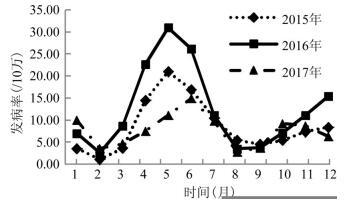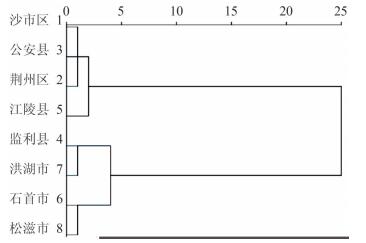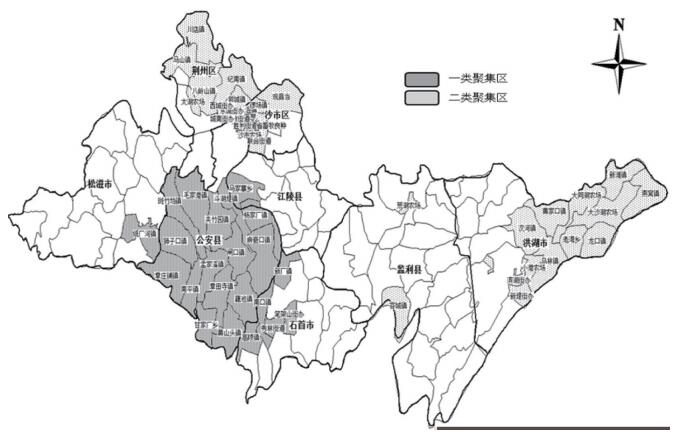扩展功能
文章信息
- 刘天, 姚梦雷, 黄继贵, 吴杨, 刘漫, 刘文慧, 王丽, 毛安禄
- Liu Tian, Yao Menglei, Huang Jigui, Wu Yang, Liu Man, Liu Wenhui, Wang Li, Mao Anlu
- 2015-2017年湖北省荆州市基于乡镇尺度的手足口病时空聚集性研究
- Analysis on spatial temporal epidemiological characteristics of hand, foot and mouth disease at township level in Jingzhou, Hubei, 2015-2017
- 疾病监测, 2018, 33(6): 473-477
- Disease Surveillance, 2018, 33(6): 473-477
- 10.3784/j.issn.1003-9961.2018.06.008
-
文章历史
- 收稿日期:2017-12-08
2. 湖北省疾病预防控制中心, 湖北 武汉 430079
2. Hubei Provincial Center for Disease Control and Prevention, Wuhan 430079, Hubei, China
手足口病是由多种肠道病毒引起的儿童常见传染病,在世界多个国家流行[1-2]。近年来,我国手足口病疫情有发病强度高、持续时间长、疫情分布广等特点,严重威胁我国儿童的身心健康[3-4]。手足口病的流行特点、时空分布、影响因素、预测预警已有相关报道[5-7],其中以流行特点及预测预警相关研究较多[1, 6]。但目前湖北省尤其是荆州地区手足口病的时空分布特点、季节性特点相关研究较少。因此,基于乡镇尺度,采用SaTScan软件进行时空扫描统计,定量分析荆州市手足口病的季节性特点和聚集区域,为该地的手足口病防控提供科学依据。
1 资料与方法 1.1 资料来源中国疾病预防控制信息管理系统传染病报告信息管理系统中2015-2017年荆州市手足口病疫情,包括确诊病例和临床诊断病例。按现住址、发病日期导出数据并统计。人口资料来源于荆州市统计局。
1.2 方法运用集中度值法定量评价手足口病的季节特点[8]。采用系统聚类法对荆州市各县(市、区)手足口病发病情况进行分类[8]。运用时空扫描统计量进行时空扫描统计[5, 8-9],探讨荆州市手足口病时空聚集性特点。
1.2.1 集中度值法[8]表示发病季节性强弱的指标,M表示集中度,计算公式见文献[8]。季节性的判断标准为:M≥0.90,说明发病有严格的季节性;M值在0.70~0.89,说明发病有很强的季节性;M值在0.50~0.69,说明发病有较强的季节性;M值在0.30~0.49,说明发病有一定的季节性;M≤0.30,说明发病时间分布比较均匀,无明显季节性。
1.2.2 系统聚类分析[8]聚类分析是研究事物分类问题的一种多元统计方法,本研究采用系统聚类中的Q型聚类进行分析,距离测量方法选择欧氏距离平方和组间平均距离法。
1.2.3 时空扫描统计量[5, 8-9]本研究采用Poisson分布模型构建扫描统计量,其基本思想是通过设定两个维度分别为空间和时间的动态变化的圆柱形窗口进行遍历扫描,对于每个扫描窗口,根据Poisson分布模型特点和人口数计算出理论发病数,然后利用扫描窗口内和扫描窗口外的实际发病数和理论发病数构造检验统计量对数似然比(log likelihood ratio,LLR),用LLR来评价扫描窗口内发病数的异常程度。选取LLR值较大的窗口为可能高发病聚集窗口,并计算该窗口的相对危险度(RR)及检验差异性。最终选取LLR值最大且有统计学意义的窗口为一级聚集区,其他LLR值较小且有统计学意义的窗口均为二级聚集区。
根据有关文献报道,聚集区域最多覆盖地理区域个数不宜超过总地理区域个数的10%~15%[9-10]。荆州市共129个乡镇,故聚集区域覆盖的乡镇数不宜>25个。本研究将最大扫描窗口分别设置为研究区域内全部风险人口数的50%、40%、30%、20%和10%,根据聚集区域的乡镇个数及一级聚类区LLR值、RR值大小选择最优的最大扫描窗口。本研究以天为时间单位,最大时间步长设定为30 d进行时空扫描。
1.3 统计学分析采用Excel 2007软件对数据进行定义、整理、分析,计算集中度值,采用SPSS 20.0软件进行Q型聚类分析。运用SaTScan 9.4.2软件进行时空扫描,并采用Mapinfo 7.0(试用版)软件对结果进行可视化呈现。率的比较采用χ2检验,检验水准α=0.05。
2 结果 2.1 一般情况2015-2017年荆州市累计报告手足口病病例19 712例,重症58例,无死亡报告病例,见表 1。各年度发病率差异有统计学义(χ2=945.76,P < 0.001)。
| 年份 | 病例数 | 人口数(10万) | 发病率(/10万) | 重症数(例) | 重症发生率(%) |
| 2015 | 5 887 | 57.29 | 102.76 | 16 | 0.27 |
| 2016 | 8 572 | 57.06 | 150.23 | 32 | 0.37 |
| 2017 | 5 253 | 56.98 | 92.19 | 10 | 0.19 |
| 合计 | 19 712 | 171.33 | 115.05 | 58 | 0.29 |
2015-2017年荆州市各月均有手足口病病例报告,3年集中度值依次分别为0.33、0.31、0.10,即2015-2016年荆州市手足口病流行有一定季节性,且发病率呈双峰分布,第1高峰出现在4-7月,第2高峰出现在11-12月;2017年荆州市手足口病无明显季节性,见图 1。

|
| 图 1 2015-2017年荆州市手足口病发病率逐月分布情况 Figure 1 Monthly incidence rate of HFMD in Jingzhou, 2015 - 2017 |
| |
2015-2017年荆州市8个县(市、区)均有手足口病病例报告。发病率居前3位的依次分别为荆州区(180.96/10万)、公安县(174.68/10万)和沙市区(164.01/10万)。按手足口病平均发病率可将各地区聚为3类,第Ⅰ类为荆州区、公安县、沙市区和江陵县,第Ⅱ类为石首市和松滋市,其他地区可聚为一类,见图 2。

|
| 图 2 2015-2017年荆州市手足口病发病率系统聚类树状图 Figure 2 Dendrogram of incidence rate of HFMD by clustering analysis, 2015-2017 |
| |
分别以研究区域内全部风险人口数的50%、40%、30%、20%和10%为最大空间扫描半径进行时空扫描时发现,当窗口比例≥30%时,聚集区域数过少,聚集区域覆盖乡镇数过多(> 25个),易造成假阳性;窗口比例≤10%时,聚集区域数量过多、分布较分散,易造成假阴性;窗口比例为20%时,聚集区域数及一类聚集区相对稳定,覆盖乡镇数合理,且一类聚集区LLR值和RR值均较大。综合分析,本研究以20%风险人口数为最大空间扫描半径进行时空扫描统计。不同窗口比例探测的空间聚集区情况见表 2。
| 窗口比例(%) | 聚集区域数 | 聚集区覆盖乡镇数的构成情况(个) | 一类聚集区 | |||||
| ≤1 | ≤10 | ≤25 | >25 | LLR值 | RR值 | |||
| 50 | 2 | 0 | 0 | 1 | 1 | 1271.92 | 5.73 | |
| 40 | 3 | 1 | 0 | 1 | 1 | 971.44 | 5.48 | |
| 30 | 5 | 2 | 0 | 2 | 1 | 822.79 | 6.10 | |
| 20 | 5 | 2 | 0 | 3 | 0 | 815.19 | 7.24 | |
| 10 | 10 | 3 | 3 | 4 | 0 | 546.28 | 8.46 | |
| 5 | 19 | 5 | 14 | 0 | 0 | 348.50 | 9.66 | |
| 注:LLR为对数似然比;RR为相对危险度 | ||||||||
以20%风险人口数为最大空间扫描半径进行时空扫描,2015-2017年共探测到5个时空聚集区域。其中一类聚集区出现在2016年4月17日至5月16日,聚集地区为公安县15个乡镇、石首市5个乡镇、松滋市及江陵县各1个乡镇;二类聚集区在3年间分别有1、1和2个。聚集时间在4-7月,聚集地区包括荆州区9个乡镇、沙市区11个乡镇、洪湖市12个乡镇和监利县2个乡镇,见表 3和图 3。
| 年份 | 聚集类型 | 聚集时间 | 聚集乡镇数〔中心乡镇,半径a(km)〕 | 实际发病数(例) | 预期发病数(例) | LLR值 | RR值 | P值 |
| 2016 | 一类聚集区 | 4月17日至5月16日 | 22(公安县孟家溪镇,32.69) | 739 | 105.53 | 815.19 | 7.24 | 0.000 |
| 2015 | 二类聚集区 | 4月26日至5月25日 | 21(荆州区纪南镇,20.56) | 581 | 84.80 | 628.24 | 7.03 | 0.000 |
| 2016 | 二类聚集区 | 5月16日至6月14日 | 12(洪湖市龙口镇,36.81) | 161 | 42.95 | 95.05 | 3.77 | 0.000 |
| 2017 | 二类聚集区 | 6月11日至7月9日 | 1(监利县容城镇,0.00) | 75 | 10.53 | 82.91 | 7.15 | 0.000 |
| 2017 | 二类聚集区 | 6月8日至7月4日 | 1(监利县荒湖农场,0.00) | 22 | 2.06 | 32.13 | 10.67 | 0.000 |
| 注:a半径为0.00指该聚集区仅覆盖聚集中心所在乡镇;LLR为对数似然比;RR为相对危险度 | ||||||||

|
| 图 3 2015-2017年荆州市手足口病发病率时空聚集区 Figure 3 Spatial temporal clusters of HFMD incidence rate in Jingzhou, 2015-2017 |
| |
时间和空间分布在疾病的描述和分析中有重要作用,而单纯时间聚集和空间聚集常只分析一个维度,时空扫描统计量则可以从时间、空间两个维度评价或预测事件的聚集性,弥补了单纯时间、空间分析的不足。SaTScan软件为时空分析提供了较好的技术支撑。目前,时空扫描统计量广泛应用于急性传染病[4-5, 9]、慢性传染病[11]和症状监测[12]等领域的监测预警,均取得了较好效果。在SaTScan中,Kulldorff[13]推荐用50%风险人口数作为默认的最大空间扫描窗口,蔡剑等[14]以10%窗口病例对浙江省手足口病疫情进行时空分析效果较好。本研究结果表明,该2个扫描窗口比例均不适用于荆州市手足口病疫情的时空分析,而以20%风险人口数作为最大扫描窗口效果较好。提示今后在时空分析时应分地区、分病种分别设置适宜的最大空间扫描窗口。
本研究结果显示,荆州市2016年手足口病疫情高于2015、2017年同期,符合刘莹莹等[15]报道的手足口病有隔年高发特点。集中度值法分析结果表明,2015和2016年荆州市手足口病发病具有一定季节性,呈双峰分布,可能与温度等气候因素变化有关[16];而2017年手足口病发病无显著季节性,其原因有待进一步研究。2015-2016年手足口病发病率第1高峰在4-7月,与时空扫描时间聚集结果一致;第2高峰在11-12月,而时空扫描未能识别,可能与秋冬季手足口病病例地区分布散在有关,或因第1高峰峰值较高而掩盖了第2高峰的特点。
时空扫描结果表明,荆州市手足口病疫情时空聚集区主要位于公安县南部15个乡镇和其与公安县周边县和市(石首市5个、松滋市和江陵县各1个)的部分乡镇,聚集时间为2016年4月17日至5月16日(LLR=815.19,RR=7.24),与县、市级尺度的聚类结果一致。该时空聚集的出现可能与以下因素有关:(1)公安县地处荆州南部,经济相对落后。居民卫生意识淡薄、卫生习惯较差为手足口病的传播提供条件。(2)公安县北临长江,县内河流湖泊众多,水系丰富,为肠道传染病的高发区[17]。本研究还发现,荆州和沙市区等城区部分乡镇为二类聚集区,与按县、市级尺度发病率排名结果不同,说明城区手足口病疫情按乡镇尺度分布较分散;监利县和洪湖市部分乡镇有3个二类聚集区,说明时空扫描可在整体疫情低发地区发现局部聚集区,再次验证时空扫描统计量较单纯空间分析更敏感、更科学。
综上所述,荆州市手足口病流行具有明显时间及空间聚集性,应以此为指导,确定手足口病的重点防控区域(公安县、荆州区、沙市区等部分乡镇),加大该地医疗卫生的投入和卫生监管力度,针对重点人群适时开展疫苗接种,保护当地儿童健康。但本研究最大时间扫描窗口参照文献[18-19]设定为30 d,未考虑时间尺度的选择,存在一定局限性,今后可对最大时间扫描窗口的最优尺度进行深入探讨。
作者贡献:
刘天 ORCID:0000-0002-5810-4318
刘天:文章撰写,统计分析
姚梦雷:技术指导、数据整理
黄继贵:技术指导
吴杨:文章审核、修改
刘漫:文章审核、修改
刘文慧:文章审核、修改
王丽:数据收集、整理
毛安禄:文章撰写、质量控制
| [1] |
Xing WJ, Liao QH, Viboud C, et al. Hand, foot, and mouth disease in China, 2008-12:an epidemiological study[J]. Lancet Infect Dis, 2014, 14(4): 308-318. DOI:10.1016/S1473-3099(13)70342-6 |
| [2] |
Aswathyraj S, Arunkumar G, Alidjinou EK, et al. Hand, foot and mouth disease(HFMD):emerging epidemiology and the need for a vaccine strategy[J]. Med Microbiol Immunol, 2016, 205(5): 397-407. DOI:10.1007/s00430-016-0465-y |
| [3] |
王佳欣, 胡茂桂, 于石成, 等. 基于面到面泊松克里格方法的手足口病发病率空间分布降尺度研究[J]. 中华流行病学杂志, 2017, 38(9): 1201-1205. Wang JX, Hu MG, Yu SC, et al. Downscaling research of spatial distribution of incidence of hand foot and mouth disease based on area-to-area Poisson Kriging method[J]. Chin J Epidemiol, 2017, 38(9): 1201-1205. DOI:10.3760/cma.j.issn.0254-6450.2017.09.012 |
| [4] |
Chen GP, Wu JB, Wang JJ, et al. Epidemiological characteristics and influential factors of hand, foot and mouth disease(HFMD)reinfection in children in Anhui province[J]. Epidemiol Infect, 2015, 144(1): 153-160. DOI:10.1017/S0950268815001107 |
| [5] |
Gui JJ, Liu ZF, Zhang TF, et al. Epidemiological characteristics and spatial-temporal clusters of hand, foot, and mouth disease in Zhejiang province, China, 2008-2012[J]. PLoS One, 2015, 10(9): e139109. DOI:10.1371/journal.pone.0139109 |
| [6] |
Du ZC, Xu L, Zhang WJ, et al. Predicting the hand, foot, and mouth disease incidence using search engine query data and climate variables:an ecological study in Guangdong, China[J]. BMJ Open, 2017, 7(10): e016263. DOI:10.1136/bmjopen-2017-016263 |
| [7] |
Long L, Gao LD, Hu SX, et al. Risk factors for death in children with severe hand, foot, and mouth disease in Hunan, China[J]. Infect Dis, 2016, 48(10): 744-748. DOI:10.1080/23744235.2016.1185801 |
| [8] |
孙建伟, 王大江, 许汴利, 等. 卫生相关事件数据时间聚集性的综合分析与判定[J]. 中国卫生统计, 2017, 34(2): 257-259. Sun JW, Wang DJ, Xu BL, et al. Comprehensive analysis and decision of time aggregation of health related event data[J]. Chin J Health Statist, 2017, 34(2): 257-259. |
| [9] |
蒋丽娜, 谭毅, 王晶, 等. 2008-2015年广西手足口病流行病学特征及时空聚集性分析[J]. 中华疾病控制杂志, 2017, 21(4): 340-344. Jiang LN, Tan Y, Wang J, et al. Epidemiological characteristics and temporal-spatial clustering of hand, foot and mouth disease in Guangxi from 2008 to 2015[J]. Chin J Dis Control Prev, 2017, 21(4): 340-344. DOI:10.16462/j.cnki.zhjbkz.2017.04.005 |
| [10] |
Xie YH, Chongsuvivatwong V, Tang ZZ, et al. Spatial-temporal clustering of hand, foot, and mouth disease at the county level in Guangxi, China[J]. PLoS One, 2014, 9(2): e88065. DOI:10.1371/journal.pone.0088065 |
| [11] |
Rao HX, Shi XY, Zhang X. Using the Kulldorff's scan statistical analysis to detect spatio-temporal clusters of tuberculosis in Qinghai province, China, 2009-2016[J]. BMC Infect Dis, 2017, 17: 578. DOI:10.1186/s12879-017-2643-y |
| [12] |
Mathes RW, Lall R, Levin-Rector A, et al. Evaluating and implementing temporal, spatial, and spatio-temporal methods for outbreak detection in a local syndromic surveillance system[J]. PLoS One, 2017, 12(9): e184419. DOI:10.1371/journal.pone.0184419 |
| [13] |
Kulldorff M. Spatial scan statistics: models, calculations, and applications[M]//Glaz J, Balakrishnan N. Scan Statistics and Applications. Boston: Birkhäuser, 1999: 303-322.
|
| [14] |
蔡剑, 陈恩富, 顾华, 等. 2008-2013年浙江省手足口病时空扫描聚集性分析[J]. 中华预防医学杂志, 2014, 48(6): 451-455. Cai J, Chen EF, Gu H, et al. Temporal-spatial scan clustering analysis on hand-foot-mouth disease in Zhejiang province, 2008-2013[J]. Chin J Prev Med, 2014, 48(6): 451-455. DOI:10.3760/cma.j.issn.0253-9624.2014.06.006 |
| [15] |
刘莹莹, 于秋丽, 苏通, 等. 2011-2015年河北省手足口病流行特征及病原特征分析[J]. 中华疾病控制杂志, 2017, 21(2): 151-155. Liu YY, Yu QL, Su T, et al. Epidemiology and etiology of hand-foot-mouth disease in Hebei province, 2011-2015[J]. Chin J Dis Contr Prev, 2017, 21(2): 151-155. DOI:10.16462/j.cnki.zhjbkz.2017.02.011 |
| [16] |
Zhao DS, Wang LL, Cheng J, et al. Impact of weather factors on hand, foot and mouth disease, and its role in short-term incidence trend forecast in Huainan city, Anhui province[J]. Int J Biometeorol, 2017, 61(3): 453-461. DOI:10.1007/s00484-016-1225-9 |
| [17] |
姚梦雷, 黄继贵. 地理信息系统在荆州市手足口病监测中的应用[J]. 公共卫生与预防医学, 2015, 26(4): 32-34. Yao ML, Huang JG. Application of Geographic Information System(GIS)for hand-foot-mouth disease(HFMD)surveillance in Jingzhou city[J]. J Pub Health Prev Med, 2015, 26(4): 32-34. |
| [18] |
毕建萍, 徐兴福, 王富良. 村级尺度的手足口病时空自相关分析[J]. 预防医学, 2016, 28(8): 796-799. Bi JP, Xu XF, Wang FL. An analysis on the temporal-spatial epidemiological characteristics of HFMD based on village scale[J]. Prev Med, 2016, 28(8): 796-799. DOI:10.19485/j.cnki.issn1007-0931.2016.08.010 |
| [19] |
李苑, 张浩洋, 张新东, 等. 时空扫描分析和圆形分布法探索手足口病聚集性的比较研究[J]. 疾病监测, 2016, 31(8): 638-641. Li Y, Zhang HY, Zhang XD, et al. Comparative study on clustering in hand foot and mouth disease based on spatial and temporal scanning analysis and circular distribution[J]. Dis Surveill, 2016, 31(8): 638-641. DOI:10.3784/j.issn.1003-9961.2016.08.006 |
 2018, Vol. 33
2018, Vol. 33


